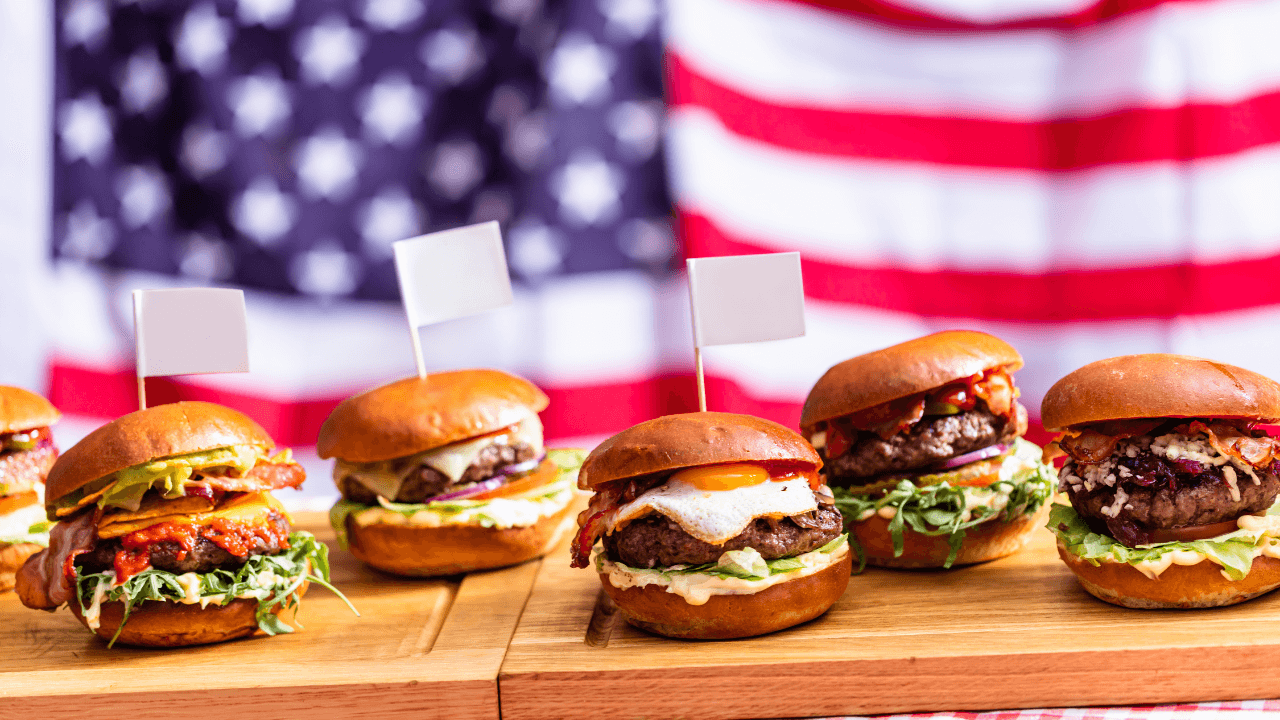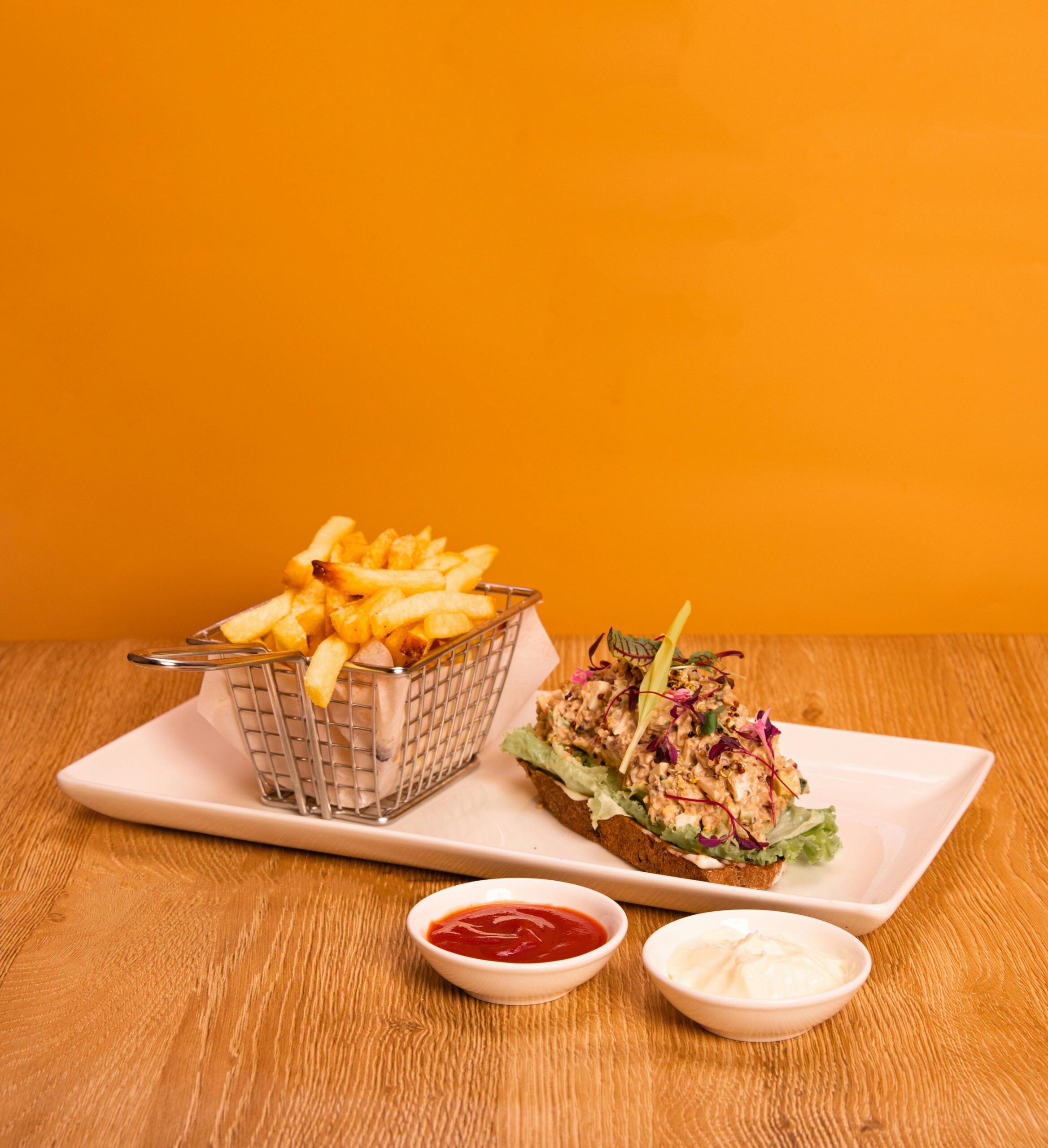- The Top Most Successful American Restaurants Today
- Should You Start a QSR or a Regular Full-Service American Restaurant?
- Essential Factors to Consider When Trying to Open Your American Restaurant
- Extra Tips from Orders.co for Starting Your American Restaurant
- Orders.co: Your Key to a Seamless Launch for Your American Restaurant Business
With its colorful red, white, and blue, the U.S. offers a mix of cultures and many different cuisines, like Louisiana Gumbo and New York hot dogs.
With so much variety, which type of restaurant do you want to run?
Starting an American restaurant business requires a mix of passion, planning, and careful execution. The dining scene is constantly changing, and knowing how to navigate it is essential for success.
In April 2023, an extensive survey found that 61 percent of people in the United States had eaten at a restaurant last month.
This shows great interest in dining out, making it a great time to start your own restaurant.
If you’re an aspiring independent restaurant owner or looking to expand your restaurant market, this guide will show you how to start an American restaurant business.
The Top Most Successful American Restaurants Today
Several establishments have risen to iconic status when defining American cuisine and dining experiences, captivating taste buds, and shaping cultural landscapes across the globe.
Here are seven of the most notable:
McDonald’s
McDonald’s isn’t just a fast-food chain; it’s a global phenomenon.
With its ubiquitous presence and menu offerings spanning from the classic Big Mac to innovative McFlurry flavors, McDonald’s has become a household name.
As of 2022, it held the title of the most valuable fast-food brand in the world, boasting an estimated brand value of a staggering 196.5 billion U.S. dollars.
Starbucks
From its humble beginnings in Seattle’s Pike Place Market to its status as an international coffee giant, Starbucks has revolutionized how the world enjoys coffee.
With a commitment to quality and customer experience, Starbucks has cultivated a loyal following.
In 2022, its brand value amounted to approximately 61.7 billion U.S. dollars, solidifying its position as a coffeehouse industry leader.
While McDonald’ and Starbucks are the leading American food and beverage businesses, here are some honorable mentions that also rack in popularity:
Subway
Known for its customizable sandwiches and fresh ingredients, Subway has become a go-to destination for quick and healthy meals.
With thousands of locations worldwide, Subway has carved out a niche in the fast-casual dining sector, offering diverse options to suit every taste.
KFC (Kentucky Fried Chicken)
A pioneer in fried chicken, KFC has become synonymous with finger-licking-good meals and Southern hospitality.
With its blend of herbs and spices and iconic buckets of chicken, KFC has captured the hearts and appetites of diners worldwide.
Pizza Hut
As one of the largest pizza chains globally, Pizza Hut has made its mark with its mouthwatering pies and innovative toppings.
Whether it’s classic pepperoni or daring stuffed crust creations, Pizza Hut continues to delight pizza lovers of all ages.
Taco Bell
Taco Bell has redefined Mexican-inspired cuisine with its bold flavors and inventive menu items.
From the iconic Crunchwrap Supreme to the beloved Doritos Locos Tacos, Taco Bell offers a unique dining experience that resonates with fans worldwide.
Chick-fil-A
Known for its delicious chicken sandwiches and exceptional customer service, Chick-fil-A has rapidly expanded its footprint across the United States.
With a commitment to quality ingredients and community engagement, Chick-fil-A has earned a dedicated following and thrives in the competitive fast-food market.
Should You Start a QSR or a Regular Full-Service American Restaurant?
According to a Statista survey, full-service restaurants saw the lowest share of respondents, indicating that they ate out more, at 13 percent.
This suggests that while full-service dining offers a distinct experience cherished by many, it may only sometimes align with the fast-paced lifestyles of modern consumers.
In contrast, fast-food chains had the highest share of respondents who preferred eating out more, at 17 percent.
This highlights the convenience and accessibility that QSRs provide, catering to the on-the-go dining habits of a significant portion of the population.
Each option has its own advantages and challenges, catering to different consumer preferences and operational dynamics.
Let’s look at some advantages and disadvantages of each:
Quick-Service Restaurants (QSR)
Advantages:
- Speed: QSRs thrive on quick service, catering to customers who are looking for fast and convenient dining options.
- Lower Labor Costs: QSRs typically require fewer staff than full-service restaurants, leading to lower labor expenses.
- Scalability: QSRs are often easier to replicate and scale, allowing for rapid expansion and franchise opportunities.
- Targeted Marketing: QSRs can focus on specific demographics and market segments, tailoring their offerings to meet the needs of their target audience.
- Consistency: QSRs often rely on standardized processes and menu items, ensuring consistency in food quality and customer experience across multiple locations.
Disadvantages:
- Limited Menu Options: Due to the emphasis on speed and efficiency, QSR menus may be more limited compared to full-service restaurants, potentially limiting customer choice.
- Perception of Lower Quality: Some consumers may perceive QSRs as offering lower-quality food compared to full-service restaurants, impacting brand perception and customer loyalty.
- Competitive Market: The QSR market is highly competitive, requiring continuous innovation and marketing efforts to stand out among competitors.
- Reliance on Drive-Thru: Many QSRs heavily rely on drive-thru sales, making them vulnerable to fluctuations in drive-thru traffic and challenges in optimizing the drive-thru experience.
- Brand Consistency Challenges: Maintaining consistent branding and customer experience across multiple franchise locations can be challenging for QSRs.
Full-Service Restaurant
Advantages:
- Improved Dining Experience: Full-service restaurants offer a more immersive dining experience with personalized service, ambiance, and attention to detail.
- Higher Profit Margins: Full-service restaurants can command higher prices for menu items and beverages, potentially leading to higher profit margins.
- Flexibility in Menu Offerings: Full-service restaurants have the flexibility to offer a diverse range of menu options, catering to various tastes and different dietary preferences.
- Upselling Opportunities: With table service, full-service restaurants have more opportunities to upsell appetizers, desserts, and specialty drinks, increasing revenue per customer.
- Building Customer Relationships: Full-service restaurants provide opportunities for staff to build rapport with customers, fostering loyalty and repeat business.
Disadvantages:
- Higher Operating Costs: Full-service restaurants typically have higher operating costs compared to QSRs, including labor, rent, utilities, and inventory expenses.
- Longer Wait Times: The table service model may result in longer wait times for customers, especially during peak hours, potentially leading to customer dissatisfaction.
- Staff Training Requirements: Full-service restaurants require well-trained staff members who excel in customer service, food presentation, and order accuracy, necessitating ongoing training and development efforts.
- Seasonal Demand Variations: Full-service restaurants may experience fluctuations in demand based on seasonality, special events, and economic factors, requiring strategic planning to manage inventory and staffing levels.
- Limited Turnover Rate: The table turnover rate in full-service restaurants may be lower compared to QSRs, potentially impacting revenue generation and table availability during peak hours.
Essential Factors to Consider When Trying to Open Your American Restaurant
Embarking on the journey of opening your American restaurant requires consideration of various factors to ensure its success.
Here are key elements to ponder before taking the plunge as a restaurant owner:
Here are key elements to ponder before taking the plunge:
Preparing a Restaurant Business Plan and Concept Development
Crafting a robust business plan involves defining your concept, conducting market research, setting objectives, and outlining financial projections.
Additionally, performing a SWOT analysis to assess strengths, weaknesses, opportunities, and threats can help you identify strategic advantages and potential pitfalls in your restaurant venture.
- Define your restaurant concept: Determine the type of American cuisine you’ll specialize in, whether it’s classic comfort food, regional specialties, or innovative fusion dishes.
- Unique Selling Proposition (USP): Identify what sets your restaurant apart from competitors and how you’ll differentiate your offerings in the market.
Restaurant Location
- Demographics: Research the demographics of potential locations to ensure they align with your target market. Consider factors such as income levels, population density, and consumer preferences.
- Foot Traffic: Evaluate foot traffic patterns and visibility for your food service business to maximize exposure and attract potential customers.
- Accessibility: Ensure easy accessibility for customers, including parking availability and proximity to public transportation.
Legal and Regulatory Compliance
- Permits and Licenses: Restaurant owners should familiarize themselves with the legal requirements for opening a restaurant, including getting a business license, health permits, liquor licenses, and zoning regulations.
- Food Safety: Implement proper food handling and safety protocols to comply with health department regulations and ensure the well-being of your customers.
Financial Planning
- Budgeting: Develop a comprehensive budget encompassing startup costs, operating expenses, and contingencies. Consider factors such as equipment purchases, lease agreements, food costs and marketing expenses.
- Funding Options: Explore financing options, including personal savings, bank loans, investors, or crowdfunding, to secure the necessary capital for your restaurant venture.
Menu Development
- Menu Selection: Curate a restaurant menu that reflects your restaurant concept and caters to the preferences of your target audience. Balance variety with simplicity to streamline operations and maintain consistency.
- Ingredient Sourcing: Source high-quality ingredients that align with your culinary vision and meet customer expectations for freshness and flavor.
Staffing and Training
- Hiring Process: Recruit skilled and passionate individuals who align with your restaurant’s culture and values. Consider factors such as experience, attitude, and work ethic during the hiring process.
- Training Programs: Develop comprehensive training programs to equip your restaurant staff with the knowledge and skills required to deliver exceptional service and uphold your restaurant’s standards.
Marketing and Promotion
- Branding: Develop a cohesive brand identity that resonates with your target audience and communicates your restaurant’s unique personality and offerings.
- Marketing Strategy: Implement a multi-channel marketing strategy to generate buzz and attract customers, including digital marketing, social media campaigns, and local advertising initiatives.
By carefully considering these essential factors, you can lay a solid foundation for your American restaurant and increase your chances of long-term success in the competitive culinary landscape.
Extra Tips from Orders.co for Starting Your American Restaurant
Here are some additional tips from Orders.co to enhance your restaurant’s chances of thriving in the competitive market:
Read the Latest Food Trends
Stay abreast of the latest food trends to meet evolving consumer preferences.
With the acceleration in consumption of plant-based foods, consider adding vegetarian options to your menu to cater to health-conscious diners and tap into this growing market segment.
Consider the Importance of Sustainability and Locally-sourced Foods
Millennials and Gen Z increasingly prioritize sustainability and eco-conscious practices when dining out. Incorporate locally sourced ingredients into your menu to support local farmers, reduce environmental impact, and appeal to socially conscious consumers.
Incorporate Technology in Various Operations
Embrace restaurant technology to streamline operations and enhance customer experiences.
Utilize AI restaurant website builders to create a user-friendly online platform for showcasing your restaurant menu and facilitating online reservations.
Implement automated email alerts for your marketing campaigns to engage with customers and drive repeat business efficiently.
Partner with Popular Delivery Apps
Leverage the popularity of delivery apps such as UberEats, DoorDash, and others to expand your restaurant’s reach and attract customers who prefer the convenience of food delivery.
Additionally, consider signing up for a platform that offers order consolidation, allowing you to manage restaurant orders from multiple delivery apps seamlessly and avoid confusion.
Utilize Local SEO
Gain more recognition during your restaurant’s opening phase by optimizing your online presence for local search.
Utilize local SEO strategies to improve your restaurant’s visibility in search engine results and attract nearby customers.
This can help scale your customer reach quickly and establish a strong local customer base.
Orders.co: Your Key to a Seamless Launch for Your American Restaurant Business
Launching your American restaurant business involves a careful blend of creativity, strategy, and attention to detail.
From choosing the right concept to navigating legal regulations and crafting a compelling menu, numerous factors must be considered on the road to success.
With Orders.co by your side, your journey becomes significantly smoother and more manageable.
Here’s how Orders.co can help in launching your American restaurant business:
- Local SEO Solutions and Optimizations:
- Gain greater visibility within your community.
- Attract more customers and establish a strong local presence.
- AI Restaurant Website Building:
- Create a professional and engaging website in seconds.
- Showcase your menu, location, and unique offerings effectively.
- Marketing Solutions Through Text and SMS:
- Reach and engage with your target audience effectively.
- Promote daily specials, announce events, and solicit feedback from customers.
- Orders Consolidation:
- Manage all your orders in one location.
- Track, process, and fulfill orders from various sources seamlessly within the Orders.co platform.
- Menu Management:
- Update online menus efficiently.
- Automatically generate enticing dish descriptions using AI technology.
- Guest Feedback Monitoring:
- Receive real-time feedback from customers through your website.
- Get email alerts for new feedback submissions to stay informed and responsive.
- Loyalty Rewards Programs:
- Drive traffic to your website.
- Incentivize repeat business with customizable rewards programs.
- Reward loyal customers with discounts, freebies, or exclusive perks to encourage long-term relationships and customer retention.
Book a FREE demo call with Orders.co’s comprehensive support and resources.
You can confidently navigate the complexities of launching your American restaurant business and positioning yourself for long-term success in the competitive culinary landscape.



